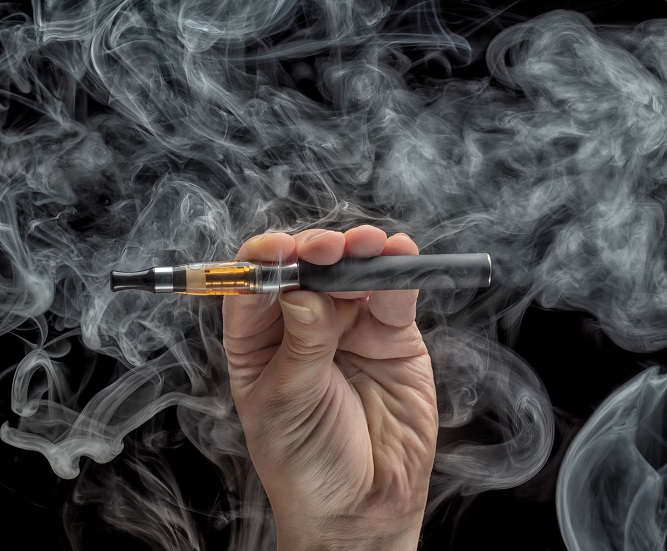Many of the classic debates in clearing acne have been around for decades now. The likes of milk, chocolate and greasy food have been debated since the 1960s, but one of the newer controversies in clear skin land is e-cigarettes.
Electronic cigarettes were invented and patented way back in 1963. However, the industry lay dormant until 2003 when a heavy smoking addict from China created the modern form. At first, big tobacco fought back hard, but then adopted an “if you can’t beat ’em, join ’em” policy”. They bought up the smaller e-cigarette companies, and are finally raking in the cash again after years of having an “evil” image.
E-cigarette usage increased from 1.8% of the population in 2010 to 13% in 2013. The flavours run into the thousands, including vanilla, double chocolate, java, cherry, apple pie, pink champagne, mother’s milk and gingerbread.
E-cigarette stores are now resorting to the classic marketing campaigns of the 1930s. It’s the oldest trick in the book: giant images of smiling models holding e-cigarettes to create a glamorous image. Even non-smokers are now trying e-cigarettes.
However, the main attraction is getting the addiction-reliving hit of nicotine without the tobacco, and without the 600 additives. The implications for acne would be huge, as cigarettes are easily one of the worst habits behind it. You ingest over 300 trillion free radicals per puff of a newly lit cigarette, and they deplete many vital acne nutrients such as vitamin E.
Are e-cigarettes a skin-friendlier alternative to normal ones?
E-cigarettes and acne – the testimonials
The first problem is that e-cigarettes are so new. With normal cigarettes, it took decades for scientists to notice the lung cancer link, and longer to prove it.
Luckily, we have multiple testimonials from acne patients. One users complained of certain e-cigarette juices breaking him out, while another complained of persistent acne that lasted for years. However, there’s just as many acne patients reporting nothing, a smooth and easy ride. The testimonials are an inconsistent mess…
…but there is one interesting subplot. Numerous acne patients report that shifting the PG/VG ratio towards glycerine improves their skin problems:
- I found out that I was having a reaction to the pg. Got 100% vg. It cleared right up”.
- “I had pg sensitivities that gave me a rash, like razor bumps. Lowering the pg made all the difference”.
- “I switched to 100VG thinking that PG may have been an issue. Within a few days the rash went away and I have been happily vaping with 100VG since”.
If you’re an e-cigarette newbie, then PG and VG stand for propylene glycine and vegetable glycerol. These chemicals are the transporters used to deliver the nicotine which is incinerated in fluid form. The sensations are noticeably different, as propylene glycol provides a sharp throat hit closer to tobacco smoke. Vegetable glycerine, meanwhile, gives a thick sensation to the vapour, which many find satisfying.
Read Annihilate Your Acne – get the greatest diet ever for clear and radiant skin
By default, most e-cigarette products combine a 50:50 ratio. However, customers can alter the ratios themselves, to get their preferred sensation, and VG is what the acne patients recommend.
Properly glycerol – the main e-cigarette suspect
So what exactly is propylene glycol? It’s automatically suspicious in natural health circles since it’s a petroleum by-product. PG is a fluid with no colour or odour. It’s common usage an an anti-freeze also helps to spread the fear.
The truth is that PG is deemed to be “generally recognised as safe by the FDA, when used as a food additive. Inhaling PG (our main interest) was deemed to be harmless by a study in 1947. PG’s main negative quality is minor skin irritation when applied topically (study, study).
Here at Supernatural Acne Treatment, we despise the epidemic of artificial chemicals lurking in cosmetics and food. Propylene glycol evidently isn’t close to a BPA or sodium fluoride, but something is clearly afoot, unless the testimonials were all wrong.
There could be subtle negative powers which the study has missed; remember that heart-clogging trans-fats (now banned) were given safe status by the FDA in 1957.
There’s one other possibility though, because e-cigarettes contain only 10% of the nicotine content of tobacco cigarettes per single puff. Its possible that the e-cigarette victims were reacting to the lower content – a spike in stress hormones, as their addiction was less satisfied than normal.
After two weeks, their bodies might have adapted to the lower nicotine, but if this coincided with the switch to higher VG rations, it would create the illusion that PG was responsible.
The jury’s out, but PG is one of the main e-cigarette suspects.
Diacetyl the popcorn chemical
The average tobacco cigarette contains over 600 contaminants. Electronic cigarettes, meanwhile, have merely a few base ingredients: nicotine, propylene glycol, vegetable glycerine, water, and flavourings.
One such artificial flavouring is diacetyl. It adds a buttery taste to microwave popcorn, but many factory workers inhaling the chemical have developed inflammation and permanent scarring of the airways, dubbed “popcorn lung”.
In one study, Harvard researchers selected 51 different flavours of e-cigarette. Interestingly for our acne investigation, the flavours chosen were mainly ones marketed towards youths.
47 out of 51 contained artificial chemical flavours, and 39 contained the chemical diacetyl. It wasn’t just buttery flavours either; alcohol, fruit, and candy flavours all contained it. E-cigarette brands that didn’t disclose diacetyl as an ingredient were still found to contain it.
This study found that the notorious respiratory problems of diacetyl were mainly down to oxidative stress. The threat to your skin is simple – a depletion in antioxidants, to deactivate the rampaging free radicals.
This doesn’t ruin e-cigarettes completely, but it’s our first provable flaw.
Heavy metal havoc
Next on our list is the heavy metals. You might know that mercury and company are constantly hiding in cigarettes. For example, cadmium was a former pesticide which still lingers in the soil of tobacco fields, and is particularly well absorbed by the tobacco plant’s roots (study).
Next: the 6 vitamins and minerals which can massively reduce acne
But e-cigarettes are different; the metals come from the presence of nickel, silver and tin in the cartridge and wires themselves. This study found higher levels of the aforementioned three metals than regular cigarettes, while this study discovered the presence of tin and cadmium.
These metals are sucked into your body as you unsuspectingly breathe. The quantities were nowhere near the safety limit, but low doses of heavy metals are everywhere: tap water, air pollution, conventional fruit and vegetables. They combine to from a greater whole, and therefore, adding further low doses is a big mistake.
Heavy metals cause acne by depleting antioxidants and increasing inflammation. Some like arsenic have unique powers, increasing keratin and clogging pores.
Luckily, tobacco cigarettes are much deadlier for heavy metals, but any amount is a moderate negative.
The formaldehyde controversy
Next up for inspection is formaldehyde. Over the last two years, this chemical has been the main vehicle for opponents of e-cigarettes to make their point.
It started with a January 2015 study, featuring the shocking claim that formaldehyde levels in e-cigarette vapour were high enough (higher than tobacco cigarettes) to increase the lifetime risk of cancer 5-15 fold. Formaldehyde is a probable carcinogen which is used as an insecticide and to preserve dead bodies.
Media chaos ensued, but it transpired that the puffing technique tested would never be used in real life. The electronic cigarette was turned up to a setting of 5 volts compared to the normal 3.3 volts, with short frequent puffs being taken. This high activity caused the machine to overheat – hence the production of this evil chemical. What they tested is called a “dry puff”; only smoking diehards enjoy those painful settings.
The findings were discredited, and in March 2016 a new study was revealed. But this cleared up nothing.
The reassuring results showed that even 350 daily puffs on an e-cigarette with normal settings would leave only traces of formaldehyde. The problem with the study was its funding source: big tobacco, in the smoky shape of the British American Tobacco company.
The results could still be accurate, but the clouds of mystery are still swirling.
For now, we can say that the formaldehyde connection in e-cigarettes is far from proven, unlike normal cigarettes, which produce the chemical via the burning of sugar in the tobacco leaves.
The bigger picture emerges
Unfortunately, we don’t have a single e-cigarette study directly on acne. But we do have one on oxidative stress, the main root cause (alongside inflammation), the situation when antioxidants are depleted and free radicals are assuming control.
The 7 greatest topical treatments for naturally clear skin
The study gathered 20 smokers and 20 non-smokers. They were ordered to smoke traditional tobacco cigarettes for a week. Subsequently they were ordered to smoke e-cigarettes with the same nicotine content for a week.
Blood samples were taken before and after each change. Vitamin E fell by identical amounts with both cigarettes, but all other measurements of oxidative stress, including 8-iso-prostaglandin F2a, deteriorated significantly more during the tobacco period.
This led the scientists to the following conclusion: “both cigarettes have unfavorable effects on markers of oxidative stress… after single use, although e-Cigarettes seemed to have a lesser impact”.
Once again, e-cigarettes are still bad for your skin, but to a lesser extent than tobacco cigarettes.
What about nicotine itself?
The tidings are good, as none of nicotine’s powerful physiological effects seem to wind up affecting the skin.
Scientifically, nicotine is an alkaloid found not only in 0.6-3% concentration in tobacco leaves, but also other nightshade species like potatoes, tomatoes and eggplant. Its strongest impacts are felt in the brain, not only in creating an addition, but in increasing memory, motor skills and alertness, at clinically significant levels. These effects are actually part of the nicotine high, although at a later stage, the “pleasure” is usually relief from the stress of addiction. Some businessmen are even dubbing nicotine the new “smart drug”.
Other benign effects include the release of serotonin (happiness), dopamine (motivation), and beta-endorphins (opioid style pleasure), neurotransmitters which are the main part of the high. Nicotine also prolongs the benefits of existing dopamine.
Vitamin D – the greatest nutrient for a bright and glowing skin tone
The main negative effects, apart from the obvious one, are minor cardiovascular problems and birth defects, with a possibility of tumour formation at high doses. None are particular linked to acne.
Therefore, it’s safe to say that nicotine is a non-factor for acne, except maybe the consequences of withdrawal like stress and anxiety. The contaminants of e-cigarettes remain the threat.
Do nutritional e-cigarettes work?
One of the weirder products of recent times is the “healthy” e-cigarette.
Turning the old unhealthy cigarette mythology on its head, many manufacturers are loading their products with vitamins and minerals, supposedly turning them into a multivitamin you can smoke. Vitamin E, vitamin C, vitamin B12 and vitamin A are commonly included. Even herbs such as ginseng and rhodiola rosea get thrown in sometimes. It’s turning into a money-raking free-for-all just like all the wacky flavours out there.
Is this another reason to ditch tobacco? Definitely not, because there’s no evidence that the vitamins are absorbed.
Firstly, vitamins are notoriously delicate compared to minerals. The likes of broccoli have to be cooked with special care to preserve the vitamin C (steaming is superior). If you vaporise the liquid mixture in e-cigarettes, then very little will survive.
Secondly, the majority of the vitamins in the vapour will be lost as you exhale. Some will remain, but it is simple luck as to whether it stays in your mouth or flows away forever.
Finally, vitamins are designed to be eaten and absorbed through the small intestine. Inhaling them is an inefficient way to get them inside your bloodstream; even topical application is superior. The molecules must make their way down to the lungs before the main contact with blood vessels is established.
Even considering those points, the quantities are tiny. In one brand, the vitamin C, B12, and E contents are 1000mcg, while the vitamin A content is 1IU. In a high-potency multivitamin with perfect absorption, those quantities would still be laughed at.
1000mcg equals 1mg; the RDA for vitamin C is 60mg, and even that is considered too low. You can take well over 1000mg daily to improve your acne. The vitamin A content is 1/5000th of the daily allowance.
It seems that these wonder cigarettes are little more than an elaborate marketing ploy. Watch out!
Your e-cigarette strategy for clear skin
We probably won’t know the full story on e-cigarettes for another twenty years yet. They’re certainly not clean and pristine like advertisers would have you to believe. There’s enough contaminants lurking inside to trigger oxidative stress, and the PG looks like a problem according to ever-mounting testimonials.
Nevertheless, if you’re addicted to tobacco cigarettes, AKA “death sticks”, then e-cigarettes will probably be a decent improvement.
What is an issue for acne, however, is the vitamin E depletion. Vitamin E is the most important acne vitamin of all; it’s unskippable for ending clogged pores. It’s also fair to guess that e-cigarettes deplete vitamin C and vitamin A, as tobacco smoke does the same and their destruction of vitamin E was roughly equal in the study above.
Your solution then, is to keep your vitamin E and C supplies higher than you would otherwise. You should also throw in an extra serving of fruits or vegetables, as a buffer against the oxidative stress. Shifting the PG/VG ratio is your final reserve strategy; keep it in mind.
Green tea – proven to reduce acne by up to 51% after 8 weeks
Ignore vitamin vapers, and I’d advise against particular fancy favours as well. The crazier the flavour, whether it’s dragon’s blood or gummi bear, the more complex the chemical concoction. Get in, get your nicotine, and get out – if you want to enjoy some flavour stick to food.
Finally, stick to the standard lower voltage settings, or the formaldehyde threat will surface.
Natural strategies for breaking the addiction
 There’s another option available to you – bypass e-cigarettes by quitting nicotine entirely.
There’s another option available to you – bypass e-cigarettes by quitting nicotine entirely.
It’s easier said than done, but there’s multiple natural strategies for manipulating your mood and brain which you may be unaware of. Remember that if you’re 30, 40, or even 50, it’s never too late to kick your addiction out:
Exercise intensely – a release of beta-endorphins is one of the main sources of the nicotine high. Pushing yourself to the limit in the gym, running up a mountain, or even cycling in the garage on an exercise bike is another way to release them. Replace one source of a high with another.
Even better, set a specific goal in your exercise. Why? Success of any kind stimulates dopamine. The exhilaration from selling your stocks on a high, winning a videogame, or watching your favourite football team win, all comes from dopamine. So for example, decide to do 15 minutes on your exercise bike on the second highest setting, and achieve it.
Eat dark chocolate – stressed out people tend to flock to chocolate. It’s been proven in studies as well. Cocoa powder and hence dark chocolate contains anandamide, a cannabinoid mimic which produces feelings of bliss.
Dark chocolate also contains a stimulant called theobromine, which is structurally related to caffeine. If you’re burnt out on caffeine, then very dark chocolate is an alternative way to get fired up.
Correct your magnesium levels – at 80% of the US population, magnesium is by far the mineral with the biggest deficiency rates. It happens that magnesium is a precursor to numerous neurotransmitters, and luckily, serotonin is one of them.
Basically, you are near guaranteed to lack a mineral which creates pleasure through the exact same mechanism as cigarettes. This is one strategy I definitely recommend. An article on magnesium can be found here.
Get sunlight – the sunlight high is a real phenomenon. Once again, you can replace the endorphins of nicotine with those from humanity’s trusted ally the sun. This study found that exposing mice to UV rays elevated their endorphin levels by 30-50% during the same day.
You probably know of this first hand; after a day on the beach you feel great, regardless of whether the day was particularly fun. This feeling is believed to be nature’s way of encouraging us to get vitamin D.
Vitamin D – speaking of which, vitamin D is like the magnesium of vitamins. 1) 50% of people are deficient in it, and 2) it manufactures neurotransmitters including serotonin.
Low vitamin D levels are strongly linked to depression, including the worldwide phenomenon of winter depression. Get the strategy here.
It will still be a fight to quit nicotine, but the strategies above will improve your chances.
If you’ve got to be addicted to something, you might as well make it something that improves acne. Here are the best addictions, which you should aspire to have: exercise, dark chocolate, sunlight, coffee, fruits and vegetables, and success.
NEXT: the ultimate diet for clearing acne permanently
Thanks for reading!


